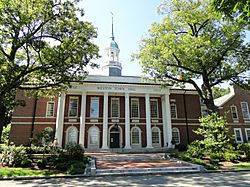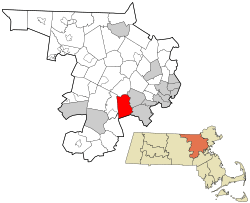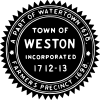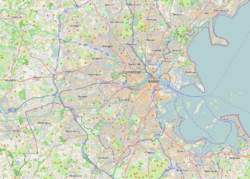Weston, Massachusetts facts for kids
Quick facts for kids
Weston, Massachusetts
|
||
|---|---|---|

Town Hall
|
||
|
||

Location in Middlesex County in Massachusetts
|
||
| Country | United States | |
| State | Massachusetts | |
| County | Middlesex | |
| Settled | 1642 | |
| Incorporated | 1713 | |
| Area | ||
| • Total | 17.3 sq mi (44.9 km2) | |
| • Land | 17.0 sq mi (44.1 km2) | |
| • Water | 0.3 sq mi (0.8 km2) | |
| Elevation | 180 ft (55 m) | |
| Population
(2020)
|
||
| • Total | 11,851 | |
| • Density | 685.0/sq mi (263.94/km2) | |
| Time zone | UTC-5 (Eastern) | |
| • Summer (DST) | UTC-4 (Eastern) | |
| ZIP Code |
02493
|
|
| Area code(s) | 781 / 339 | |
| FIPS code | 25-77255 | |
| GNIS feature ID | 0618245 | |
Weston is a town in Middlesex County, Massachusetts, in the United States. It is about 15 miles west of Boston. In 2020, about 11,851 people lived there.
Weston became an official town in 1713. The town works hard to protect its old buildings and history. It has many historic places, including one Local Historic District and 10 National Register Districts.
Weston is mostly a place where people live. It has a lot of open space, with over 2,000 acres of parks, fields, and forests. This is about 18 percent of the town's total land. There are 90 miles of trails for hiking, horseback riding, and cross-country skiing. Many scenic roads help keep the town's natural beauty and historic feel.
Contents
Exploring Weston's Past: A Town History
This history of Weston comes from the 2017 Weston Open Space and Recreation Plan.
Weston's Early Days: From Farms to Travelers
Weston was first part of the Watertown settlement in 1630. For many years, the land was mainly used for cows to graze. In 1698, the area called "The Farms" became its own section. Then, in 1712–1713, "Farmers' Precinct" officially became the town of Weston.
The first settlers found that there wasn't much good land for farming. There also wasn't much potential for factories that used water power. But Weston had one big advantage: it was on the main road west from Boston. By the 1700s, people in Weston were helping travelers on the Boston Post Road. Two old taverns, the Josiah Smith Tavern and the Golden Ball Tavern, are still around today. The Golden Ball Tavern is now a museum. North Avenue was also an important route, with shops and places for travelers.
Mills for grinding grain and cutting wood started in the 1600s near Stony Brook. Two important businesses began during this time: the Hews pottery, which made red clay pots, and Hobbs Tannery, which prepared animal hides. By 1776, Weston had 1,027 people living on farms along the main roads. Some people lived closer together in the town center.
Growth and Industry: The Railroad Era
In 1810, the Worcester Turnpike (now Route 9) opened. This road took some business away from the Boston Post Road. However, Weston's merchants still supplied goods to nearby towns until about 1830–1840. The Boston and Worcester Railroad was built through the town in 1834. The Fitchburg Railroad (later Boston and Maine) was built in the northern part of town around 1844.
Weston's population kept growing. Small industries like the pottery, tannery, and shoe-making shops helped the town. Factories making school desks, chairs, and tools also opened. The Hook & Hastings Company organ factory moved to Weston in 1888. It was the town's biggest employer until it closed during the Great Depression. A third railroad, the Mass Central Railroad, started service in 1881. It ran through the middle of town.
Weston's countryside and easy train access also made it a popular summer vacation spot. The Drabbington Lodge, once a resort, is now a place for seniors to live.
The Estate Era: Large Homes and New Buildings
Building large country estates in Weston started slowly in the 1860s and became very popular by 1900. Wealthy business people liked Weston because it was close to Boston, quiet, and had lower taxes. They also loved the beautiful area. By the early 1900s, Weston was known as a "country town of residences of the first class."
More people and the influence of these estate owners led to new public buildings. These included the First Parish Church (1888), a library (1899), a fire station (1914), and the current town hall (1917). Around 1913, a plan began to create the Town Green by improving a wet area.
Suburban growth began in the early 1900s and increased with cars. After World War I, some large estates were divided into smaller lots for homes. In the 1910s and 1920s, some estates were bought for schools like Regis College and Weston College. Others became golf courses. Many large properties remained open fields or woodlands through the Great Depression and World War II.
The Weston Aqueduct and Reservoir (1901–1903) and Hultman Aqueduct and Norumbega Reservoir (1938–1940) were big projects. They were built to help supply water to the greater Boston area.
Post-War Growth: Protecting Weston's Character
After World War II, the building of Routes 128 and the Massachusetts Turnpike led to many new homes. Former estates and farms were divided into smaller lots. The town grew very quickly after the war. Weston's leaders worked hard to control this growth and keep the town's rural feel.
In the early 1950s, Weston made two important rules to manage growth. They created a zoning rule that required more land to build a house. They also started buying land for the town, which meant less land could be developed. More than half of Weston's homes were built between 1950 and 1979. These were mostly single-family houses on land that became more and more expensive.
More people meant more demand for town services, especially schools. Five new schools were built between 1950 and 1969. In recent years, many of these post-war houses are being replaced by much larger homes.
Weston's Location and Landscape
Weston covers about 17.3 square miles (44.9 square kilometers). Most of this is land, with a small amount of water.
The town is surrounded by other towns:
- Newton and Waltham are to the east.
- Wellesley is to the south.
- Natick and Wayland are to the west.
- Lincoln is to the north.
Weston's Population and People
Weston's population has grown steadily over the years. In 1850, there were 1,205 people. By 2020, the population had reached 11,851.
In 2000, there were 11,469 people living in Weston. About 42.3% of households had children under 18. Most households (73.1%) were married couples. The average household had 2.85 people.
The population was spread out by age:
- 28.0% were under 18.
- 16.5% were 65 or older.
The median age was 42 years old.
Weston is known for being an affluent community. In 2010, about 83% of Weston's population over 25 years old had a bachelor's degree or higher.
Arts and Culture in Weston
Weston has many places and groups that support arts and culture.
Weston Public Library
The Weston Public Library has over 209,000 items. It offers many services and programs for both kids and adults. The Friends of the Weston Public Library help fund the library's local history room and art displays. They also organize music concerts and provide passes to Boston-area museums.
Weston Art and Innovation Center
The Weston Art and Innovation Center opened in 2019. It is located in Weston's Old Library building. This center offers hands-on learning in art and technology. The Weston Media Center also moved here.
Weston Media Center
The Weston Media Center is Weston's own non-profit cable TV station. It is also a media hub. The Media Center has been operating since 2009.
Weston Friendly Society
The Weston Friendly Society started in 1885. It is the second oldest community theater group in the United States. They perform musicals several times a year at the Weston Town Hall. The money they earn from their shows goes to local charities.
Local Publications
News and stories for Weston residents are published in WellesleyWeston. This magazine comes out four times a year and started in 2005. You can find it at the Weston Public Library.
Places of Worship
- First Parish Church, Unitarian Universalist
- St. Peter's Episcopal Church
Interesting Places to Visit in Weston
- Abel Allen House
- Boston Post Road Historic District
- Case Estates
- Case's Corner Historic District
- Charles River Reservation Parkways
- Edward Peirce House, Henderson House of Northeastern University
- Glen Road Historic District
- Golden Ball Tavern
- Harrington House
- Isaac Hobbs House
- Kendall Green Historic District
- Mass Central Rail Trail—Wayside
- National Register of Historic Places in Weston
- Norumbega Tower
- Rev. Samuel Woodward House
- Samuel Train House
- Silver Hill Historic District
- Spellman Museum of Stamps & Postal History
- Wellington Farm Historic District
- Weston Aqueduct
- Weston Aqueduct Linear District
- Weston Observatory, a research and education center for earth sciences at Boston College.
- Weston Reservoir
- Weston Ski Track, open from December to March at Leo J. Martin Golf Course for cross-country skiing and snowshoeing.
- Weston Station (MBTA)
Education in Weston
Weston has both public and private schools, as well as colleges.
Public Schools in Weston
Weston Public Schools runs five schools:
- Country School and Woodland School (for younger students)
- Field School (grades 4–5)
- Weston Middle School (grades 6–8)
- Weston High School (grades 9–12)
In the 2022-2023 school year, about 2,000 students were enrolled in the district. Most Weston students (79%) attend these public schools. Weston Public Schools has been part of the METCO program since 1967.
Private Schools in Weston
- Cambridge School of Weston
- Gifford School
- Meadowbrook School of Weston
- Rivers School
Colleges and Universities
- Pope St. John XXIII National Seminary
- Regis College
Transportation in Weston
Weston has several major roads and public transportation options.
Roads and Highways
The Massachusetts Turnpike (Interstate 90) goes through the southern part of Weston from east to west. Interstate 95 and Massachusetts State Route 128 run north to south along the eastern edge of town. The place where the Massachusetts Turnpike and Route 128 meet is in southeastern Weston.
Several local state highways also pass through Weston:
- U.S. Route 20 (Boston Post Road)
- Massachusetts State Route 30 (South Avenue)
- Massachusetts State Route 117 (North Avenue)
Public Transportation
Weston is served by the Kendal Green Station on the MBTA's Fitchburg Commuter Rail Line. A train ride from Kendal Green to Boston's North Station takes about 37 minutes. Weston used to have two other train stations, Silver Hill and Hastings, but they closed in 2021 due to low ridership.
The eastern edge of Weston is close to more frequent MBTA services. Riverside Station is in the nearby city of Newton. It is a park-and-ride station for the Green Line “D” Branch. This line offers service to Downtown Boston every 6 to 12 minutes. Weston residents in the southeastern part of town can reach Riverside Station quickly by car or bike.
There are also MBTA bus routes near Weston's eastern border. Bus Route 70 starts in Waltham, near Weston. It travels to Central Square in Cambridge, where you can connect to the MBTA Red Line. Another bus, Route 558, briefly enters Weston to get to Route 128 for an express trip to Riverside Station. However, it does not have any stops within Weston.
Notable People from Weston
Many interesting people have lived in Weston, including:
- Anant Agarwal — a professor and CEO of edX
- Henry T. Brown — a chemical engineer and the first African American town official
- David Frank — a musician and founding member of the band The System
- Sarah Fuller — an educator who taught Helen Keller
- Jeremy Jacobs — owner of the Boston Bruins hockey team
- Mindy Kaling – actress, who grew up in Weston
- Stephen D. Lebovitz — CEO of CBL & Associates Properties
- Grover Norquist — founder and president of Americans for Tax Reform
- Stephen Pagliuca — co-owner of the Boston Celtics basketball team
- Anne Sexton — a Pulitzer Prize-winning poet
- Amelia Vega — winner of the Miss Universe beauty pageant in 2003
- Robert Winsor — a well-known banker from the early 1900s
Sports Figures
- Ted Alfond — part-owner of the Boston Red Sox
- Steve Belkin — owner of the Atlanta Hawks
- M. L. Carr — former Boston Celtics player and coach
- Zdeno Chara — former Boston Bruins player
- Adrián González — former Boston Red Sox player
- Matt Hasselbeck — former NFL quarterback
- John Havlicek — former Boston Celtics player
- Al Horford — current Boston Celtics player
- Kyrie Irving — current Brooklyn Nets player, former Boston Celtics player
- Isaiah Kacyvenski — former NFL player
- Cedric Maxwell — former Boston Celtics player and radio announcer
- Tom Nalen – former Denver Broncos player
- Bobby Orr — player for Boston Bruins
- David Ortiz — former Boston Red Sox player
- James Pallotta — owner of the Boston Celtics and AS Roma
- Robert Parrish — former Boston Celtics player
- Jerry Remy — former Boston Red Sox player and TV announcer
- Willard Rice — 1924 Olympic hockey player
- Lee Stempniak — former Boston Bruins player
- Jeff Vinik — owner of the Tampa Bay Lightning
- Field Yates – sports analyst
- Kevin Youkilis — former Boston Red Sox player
See also
 In Spanish: Weston (Massachusetts) para niños
In Spanish: Weston (Massachusetts) para niños





